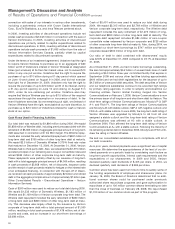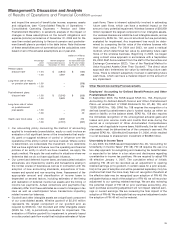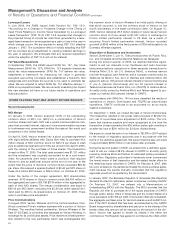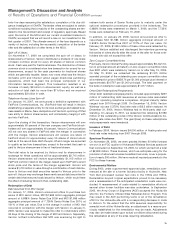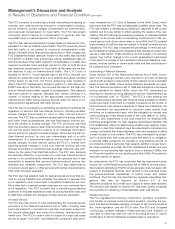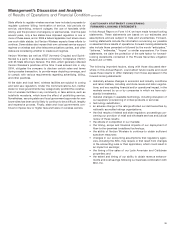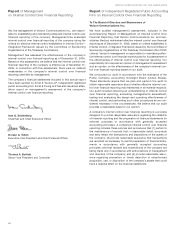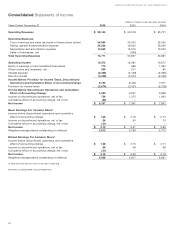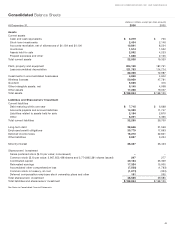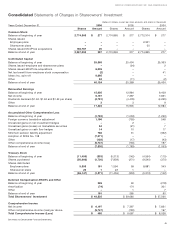Verizon Wireless 2006 Annual Report Download - page 38
Download and view the complete annual report
Please find page 38 of the 2006 Verizon Wireless annual report below. You can navigate through the pages in the report by either clicking on the pages listed below, or by using the keyword search tool below to find specific information within the annual report.
New York Recovery Funding
In August 2002, President Bush signed the Supplemental
Appropriations bill that included $5.5 billion in New York recovery
funding. Of that amount, approximately $750 million has been allo-
cated to cover utility restoration and infrastructure rebuilding as a
result of the September 11th terrorist attacks on lower Manhattan.
These funds will be distributed through the Lower Manhattan
Development Corporation following an application and audit
process. As of September 2004, we had applied for reimbursement
of approximately $266 million under Category One, although we did
not record this amount as a receivable. We received advances
totaling $88 million in connection with this application process. On
December 22, 2004, we applied for reimbursement of an additional
$136 million of Category Two losses, and on March 29, 2005 we
amended our application seeking an additional $3 million. Category
Two funding is for permanent restoration and infrastructure improve-
ment. According to the plan, permanent restoration is reimbursed up
to 75% of the loss. On November 3, 2005, we received the results of
preliminary audit findings disallowing all but $44 million of our $266
million of Category One application. On December 8, 2005, we pro-
vided a detailed rebuttal to the preliminary audit findings. We
received a copy of the final audit report for Verizon’s Category One
applications and, on January 4, 2007, we filed an appeal of the final
audit report. That appeal, as well as our Category Two applications,
are pending.
Regulatory and Competitive Trends
Competition and Regulation
Technological, regulatory and market changes have provided
Verizon both new opportunities and challenges. These changes have
allowed Verizon to offer new types of services in this increasingly
competitive market. At the same time, they have allowed other
service providers to broaden the scope of their own competitive
offerings. Current and potential competitors for network services
include other telephone companies, cable companies, wireless
service providers, foreign telecommunications providers, satellite
providers, electric utilities, Internet Service Providers, providers of
VoIP services, and other companies that offer network services
using a variety of technologies. Many of these companies have a
strong market presence, brand recognition and existing customer
relationships, all of which contribute to intensifying competition and
may affect our future revenue growth. Many of our competitors also
remain subject to fewer regulatory constraints than Verizon.
We are unable to predict definitively the impact that the ongoing
changes in the telecommunications industry will ultimately have on
our business, results of operations or financial condition. The finan-
cial impact will depend on several factors, including the timing,
extent and success of competition in our markets, the timing and
outcome of various regulatory proceedings and any appeals, and the
timing, extent and success of our pursuit of new opportunities.
FCC Regulation
Our services are subject to the jurisdiction of the FCC with respect to
interstate telecommunications services and other matters for which
the FCC has jurisdiction under the Communications Act of 1934, as
amended (Communications Act). The Communications Act generally
obligates us not to charge unjust or unreasonable rates nor engage in
unreasonable discrimination when we are providing services as a
common carrier, and regulates some of the rates, terms and condi-
tions under which we provide certain services. The FCC also has
adopted regulations governing various aspects of our business, such
as the following: (i) use and disclosure of customer proprietary net-
36
Management’s Discussion and Analysis
of Results of Operations and Financial Condition continued
work information; (ii) telemarketing; (iii) assignment of telephone num-
bers to customers; (iv) provision to law enforcement agencies of the
capability to obtain call identifying information and call content infor-
mation from calls pursuant to lawful process; (v) accessibility of
services and equipment to individuals with disabilities if readily
achievable; (vi) interconnection with the networks of other carriers;
and (vii) customers’ ability to keep (or “port”) their telephone numbers
when switching to another carrier. In addition, we pay various fees to
support other FCC programs, such as the universal service program
discussed below. Changes to these mandates, or the adoption of
additional mandates, could require us to make changes to our opera-
tions or otherwise increase our costs of compliance.
Broadband
The FCC has adopted a series of orders that recognize the competitive
nature of the broadband market, and impose lesser regulatory require-
ments on broadband services and facilities than apply to narrowband.
With respect to facilities, the FCC has determined that certain
unbundling requirements that apply to narrowband facilities do not
apply to broadband facilities such as fiber to the premise loops and
packet switches. With respect to services, the FCC has concluded that
broadband Internet access services offered by telephone companies
and their affiliates qualify as largely deregulated information services.
The same order also concluded that telephone companies may offer
the underlying broadband transmission services that are used as an
input to Internet access services through private carriage arrange-
ments on negotiated commercial terms. In addition, a Verizon petition
asking the FCC to forbear from applying common carrier regulation to
certain broadband services sold primarily to larger business customers
when those services are not used for Internet access was deemed
granted by operation of law on March 19, 2006 when the FCC did not
deny the petition by the statutory deadline. Both the FCC’s order
addressing the appropriate regulatory treatment of broadband Internet
access services and the relief obtained through the forbearance peti-
tion are the subject of pending appeals.
Video
The FCC has a body of rules that apply to cable operators under
Title VI of the Communications Act, and these rules also generally
apply to telephone companies that provide cable services over their
networks. In addition, companies that provide cable service over a
cable system generally must obtain a local cable franchise. On
December 21, 2006, the FCC announced the adoption of rules under
Section 621 of the Communications Act to set parameters consis-
tent with federal law, on the timing and scope of franchise
negotiations by local franchising authorities.
Interstate Access Charges and Intercarrier Compensation
The current framework for interstate access rates was established in
the Coalition for Affordable Local and Long Distance Services
(CALLS) plan, which the FCC adopted on May 31, 2000. The CALLS
plan has three main components. First, it establishes portable inter-
state access universal service support of $650 million for the
industry that replaces implicit support previously embedded in inter-
state access charges. Second, the plan simplifies the patchwork of
common line charges into one subscriber line charge (SLC) and pro-
vides for de-averaging of the SLC by zones and class of customers.
Third, the plan set into place a mechanism to transition to a set
target of $.0055 per minute for switched access services. Once that
target rate is reached, local exchange carriers are no longer required
to make further annual price cap reductions to their switched access
prices. As a result of tariff adjustments which became effective in
July 2003, virtually all of our switched access lines reached the
$.0055 benchmark.






